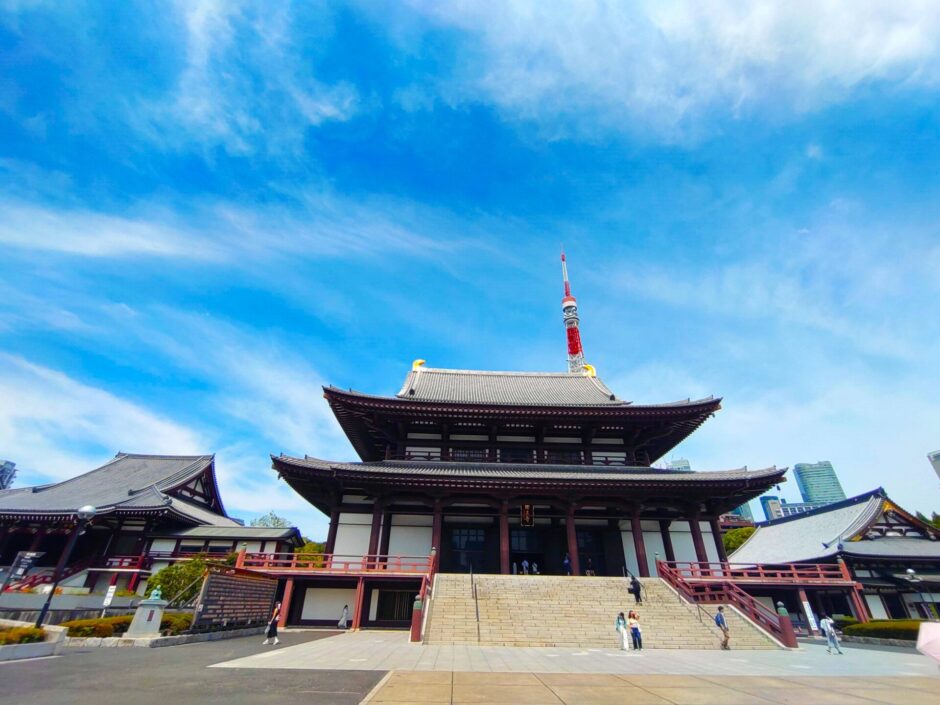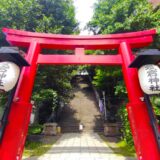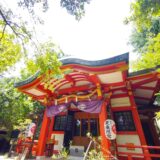目次
- 【Zojo-ji Temple summary】
- 【Zojo-ji Temple Daimon(large front gate)】
- 【Zojo-ji Temple Sangedatsu-mon Gate(Three Liberation Gates)】
- 【Zojo-ji Temple Precincts】
- 【Zojo-ji Temple Precincts Shoro Dojo(Belfry Hall)】
- 【Zojo-ji Temple Precincts nave】
- 【Zojo-ji Temple Precincts Cemetery of the Tokugawa Shoguns】
- 【Zojo-ji Temple Precincts Sentai Kosodate Jizo Bosatsu (Thousand-body Child Raising Jizo Bodhisattva)】
- 【Zojo-ji Temple Onarimon (Gate of Onari)】
- 【Zojo-ji Temple Nearby attractions】
- 【Zojo-ji Temple Access】
- Manager’s Comments
- Zojo-ji Temple
【Zojo-ji Temple summary】
Zojoji Temple, founded in 1394, has a history of more than 600 years and was founded in the Muromachi period (1336-1573) by the eighth founder of the Jodo sect, Shonin Yuho Shosho. In 1590, shortly after Tokugawa Ieyasu took control of the Kanto region during the Azuchi-Momoyama period, the temple was chosen as the family temple of the Tokugawa family and moved to its current location in 1598. It is said that this site was chosen because it is located in the direction of the back ogimon (unlucky direction), opposite Kan-eiji Temple in Ueno, as seen from the former Edo Castle.
【Zojo-ji Temple Daimon(large front gate)】
![Zojo-ji Temple [Tokyo] DSC 0602 1024x768 - Zojo-ji Temple [Tokyo]](https://japan-shrine.info/wp-content/uploads/DSC_0602-1024x768.jpg)
The main gate of Zojoji Temple. Visitors to Zojo-ji Temple must pass through this gate before entering the temple. Located on the street leading from the Daimon subway station to Zojoji Temple, it is the main gate of Zojoji Temple and the gate from which the name of the area is derived. Rebuilt in 1937 with reinforced steel-framed concrete, it was revived in 2017 with seismic reinforcement and a new exterior paint job to give it a new look.
【Zojo-ji Temple Sangedatsu-mon Gate(Three Liberation Gates)】
![Zojo-ji Temple [Tokyo] DSC 0584 1024x768 - Zojo-ji Temple [Tokyo]](https://japan-shrine.info/wp-content/uploads/DSC_0584-1024x768.jpg)
The Sangedatsu-mon Gate is one of the largest gates in eastern Japan, and is the front and central gate of Zojoji Temple. It is one of the few buildings that survived the war and still retains the atmosphere of the prosperous Edo period, and is one of the oldest wooden structures remaining in Tokyo. It is one of the oldest wooden structures remaining in Tokyo and is now designated as a National Important Cultural Property.
![Zojo-ji Temple [Tokyo] DSC 0561 1024x768 - Zojo-ji Temple [Tokyo]](https://japan-shrine.info/wp-content/uploads/DSC_0561-1024x768.jpg)
The three gates of liberation are said to be the gates of liberation that create the mind to enter the Pure Land of Ultimate Bliss, free from the three poisons of greed, anger, and folly. It is said that by passing through the gate, one will be freed from the three worldly desires. It is a large and powerful gate, but when you actually see it, you will realize that there are pillars that need to be repaired. In fact, it is said that the upper pillars have been leaning, and there are plans to dismantle and repair them over the next 10 years.
【Zojo-ji Temple Precincts】
![Zojo-ji Temple [Tokyo] DSC 0562 1024x768 - Zojo-ji Temple [Tokyo]](https://japan-shrine.info/wp-content/uploads/DSC_0562-1024x768.jpg)
After passing through the Sangakkaimon gate, you will see the main hall and Tokyo Tower. Perhaps because the grounds are large and open, the temple is less crowded than Sensoji Temple.
【Zojo-ji Temple Precincts Shoro Dojo(Belfry Hall)】
![Zojo-ji Temple [Tokyo] DSC 0574 1 1024x768 - Zojo-ji Temple [Tokyo]](https://japan-shrine.info/wp-content/uploads/DSC_0574-1-1024x768.jpg)
The bell tower is located on the right hand side of the Sankeimon gate. It is said to be the first temple bell cast in Edo period (1603-1868). It was built in 1633, but was rebuilt after the war after it was destroyed by fire. It is one of the three largest bells in eastern Japan and is designated as a cultural asset of Minato City.
【Zojo-ji Temple Precincts nave】
![Zojo-ji Temple [Tokyo] DSC 0568 1024x768 - Zojo-ji Temple [Tokyo]](https://japan-shrine.info/wp-content/uploads/DSC_0568-1024x768.jpg)
Although the temple suffered two major fires in the Meiji period (1868-1912) and an air raid on Tokyo in the Showa period (1926-1989), it was rebuilt and reconstructed in 1974. Although the temple is relatively new, it has a majestic atmosphere. The main hall of the temple is so large that it competes with Sensoji Temple for the second largest, and when you see it in person, you will be overwhelmed by its size.
【Zojo-ji Temple Precincts Cemetery of the Tokugawa Shoguns】
![Zojo-ji Temple [Tokyo] DSC 0577 1024x768 - Zojo-ji Temple [Tokyo]](https://japan-shrine.info/wp-content/uploads/DSC_0577-1024x768.jpg)
Six shoguns and their relatives, including the 2nd Shogun, Hidetada, are buried in the “Tokugawa Shoguns’ Family Cemetery”. The six shoguns are Hidetada (2nd Shogun), Ienobu (6th Shogun), Ietsugu (7th Shogun), Ieshige (9th Shogun), Iekei (12th Shogun), and Ieshige (14th Shogun). (Entrance fee: 500 yen)
【Zojo-ji Temple Precincts Sentai Kosodate Jizo Bosatsu (Thousand-body Child Raising Jizo Bodhisattva)】
![Zojo-ji Temple [Tokyo] DSC 0582 1024x768 - Zojo-ji Temple [Tokyo]](https://japan-shrine.info/wp-content/uploads/DSC_0582-1024x768.jpg)
Since the late 1970s, an increasing number of women have come to Zojoji Temple to pray for the safe delivery of their children. In order to fulfill the wishes of these women, Jizo Bosatsu statues began to be erected gradually in the 1980s. If parents are sad forever, their children who could not be born will also remain sad. It is Japanese culture to wish for the happiness of the child and to heal the heart of the parents.
【Zojo-ji Temple Onarimon (Gate of Onari)】
![Zojo-ji Temple [Tokyo] DSC 0558 1024x768 - Zojo-ji Temple [Tokyo]](https://japan-shrine.info/wp-content/uploads/DSC_0558-1024x768.jpg)
Onarimon refers to the gate used by feudal lords and temples to welcome noblemen. The Onarimon gate of Zojoji Temple was originally built as a back gate, but it became an exclusive gate for the Shogun to visit the temple. It was originally built as a back gate, but at some point it became the exclusive gate for the Shogun’s visit to the temple. It was not damaged by the Tokyo Air Raid, and has remained undamaged to this day. It is currently located on the north side of the parking lot of the Tokyo Prince Hotel, and is fenced off so that no one can pass through.
【Zojo-ji Temple Nearby attractions】
Tokyo Tower, Shiba Toshogu Shrine, Shiba Daijingu Shrine, Atago Shrine
【Zojo-ji Temple Access】
Manager’s Comments
The contrast between Tokyo Tower, the symbol of Tokyo, and Zojoji Temple, the symbol of Edo, is wonderful. It seems to be very popular among foreign tourists, and more than half of the visitors were from overseas. In Kyoto, we are conscious of the landscape and there are no tall buildings or towers, but Tokyo offers a different view. I think it is a must-see tourist spot in Tokyo.
 Tour of Japanese shrines and temples
Tour of Japanese shrines and temples 

![Zojo-ji Temple [Tokyo] 27246462 m 520x300 - Zojo-ji Temple [Tokyo]](https://japan-shrine.info/wp-content/uploads/27246462_m-520x300.jpg)
![Zojo-ji Temple [Tokyo] DSC 1820 520x300 - Zojo-ji Temple [Tokyo]](https://japan-shrine.info/wp-content/uploads/DSC_1820-520x300.jpg)
![Zojo-ji Temple [Tokyo] DSC 0610 1 520x300 - Zojo-ji Temple [Tokyo]](https://japan-shrine.info/wp-content/uploads/DSC_0610-1-520x300.jpg)
![Zojo-ji Temple [Tokyo] DSC 0592 520x300 - Zojo-ji Temple [Tokyo]](https://japan-shrine.info/wp-content/uploads/DSC_0592-520x300.jpg)
![Zojo-ji Temple [Tokyo] DSC 0545 520x300 - Zojo-ji Temple [Tokyo]](https://japan-shrine.info/wp-content/uploads/DSC_0545-520x300.jpg)
![Zojo-ji Temple [Tokyo] DSC 0610 1 150x150 - Zojo-ji Temple [Tokyo]](https://japan-shrine.info/wp-content/uploads/DSC_0610-1-150x150.jpg)
![Zojo-ji Temple [Tokyo] DSC 1820 150x150 - Zojo-ji Temple [Tokyo]](https://japan-shrine.info/wp-content/uploads/DSC_1820-150x150.jpg)
![Zojo-ji Temple [Tokyo] DSC 0592 150x150 - Zojo-ji Temple [Tokyo]](https://japan-shrine.info/wp-content/uploads/DSC_0592-150x150.jpg)
![Zojo-ji Temple [Tokyo] DSC 0545 150x150 - Zojo-ji Temple [Tokyo]](https://japan-shrine.info/wp-content/uploads/DSC_0545-150x150.jpg)

